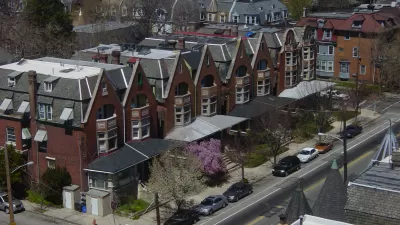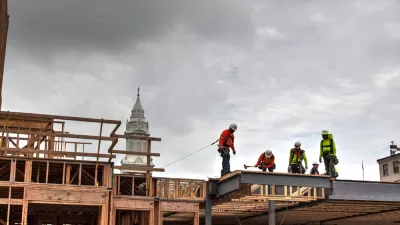Qualifying developments are eligible for a ten-year tax abatement in Philadelphia. These op-ed authors say the abatement doesn't work as anything other than a government payout.
Ira Goldstein, president of Policy Solutions, and Emily Dowdall, chief of development and policy implementation at the Reinvestment Fund, write a guest opinion piece for the Philadelphia Inquirer:
Philadelphia’s 10-year tax abatement is fundamentally a tax expenditure: not the benign concept of “money we never had” but more like writing a check from the city to the developers or buyers of new or substantially rehabilitated properties. Extreme cases such as abating $2 million townhouses prompt us to ask: Is this a wise expenditure for the city or school district?
The opinion piece was prompted by news of a luxury townhome development, each of the ten units expected to sell for $2 million, that would receive the tax abatement. "Assume an average price for these townhouses of $2 million per unit and that 20 percent of the $2 million is the value of the land for which tax will be owed; $1.6 million per unit will be exempt from the Philadelphia real-estate tax," explain Goldstein and Dowdall. "The city’s annual tax expenditure per unit will be $23,315 per unit (with the proposed 2019 tax rate of 1.4572)."
The writers present their argument against the abatements by refuting a series of arguments in favor of the abatements—i.e., the market requires stimulation, the abatement lowers the cost of construction, and it's an investment that eventually yields more revenue.
FULL STORY: Let's cap Philly's 10-year tax abatement to be fair to all

Trump Administration Could Effectively End Housing Voucher Program
Federal officials are eyeing major cuts to the Section 8 program that helps millions of low-income households pay rent.

Planetizen Federal Action Tracker
A weekly monitor of how Trump’s orders and actions are impacting planners and planning in America.

Ken Jennings Launches Transit Web Series
The Jeopardy champ wants you to ride public transit.

Washington Legislature Passes Rent Increase Cap
A bill that caps rent increases at 7 percent plus inflation is headed to the governor’s desk.

From Planning to Action: How LA County Is Rethinking Climate Resilience
Chief Sustainability Officer Rita Kampalath outlines the County’s shift from planning to implementation in its climate resilience efforts, emphasizing cross-departmental coordination, updated recovery strategies, and the need for flexible funding.

New Mexico Aging Department Commits to Helping Seniors Age ‘In Place’ and ‘Autonomously’ in New Draft Plan
As New Mexico’s population of seniors continues to grow, the state’s aging department is proposing expanded initiatives to help seniors maintain their autonomy while also supporting family caregivers.
Urban Design for Planners 1: Software Tools
This six-course series explores essential urban design concepts using open source software and equips planners with the tools they need to participate fully in the urban design process.
Planning for Universal Design
Learn the tools for implementing Universal Design in planning regulations.
Heyer Gruel & Associates PA
Ada County Highway District
Institute for Housing and Urban Development Studies (IHS)
City of Grandview
Harvard GSD Executive Education
Toledo-Lucas County Plan Commissions
Salt Lake City
NYU Wagner Graduate School of Public Service





























